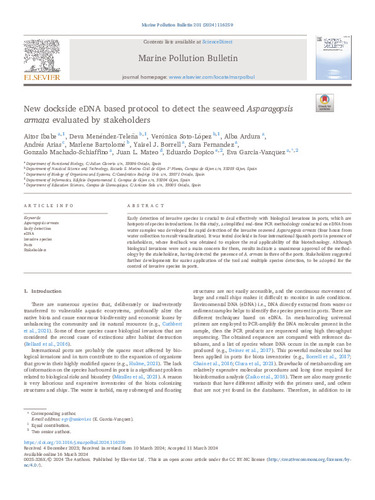New dockside eDNA based protocol to detect the seaweed Asparagopsis armata evaluated by stakeholders
Palabra(s) clave:
Asparagopsis armata
Early detection
eDNA
Invasive species
Ports Stakeholders
Fecha de publicación:
Editorial:
Elsevier
Versión del editor:
Citación:
Resumen:
Early detection of invasive species is crucial to deal effectively with biological invasions in ports, which are hotspots of species introductions. In this study, a simplified end-time PCR methodology conducted on eDNA from water samples was developed for rapid detection of the invasive seaweed Asparagopsis armata (four hours from water collection to result visualization). It was tested dockside in four international Spanish ports in presence of stakeholders, whose feedback was obtained to explore the real applicability of this biotechnology. Although biological invasions were not a main concern for them, results indicate a unanimous approval of the methodology by the stakeholders, having detected the presence of A. armata in three of the ports. Stakeholders suggested further developments for easier application of the tool and multiple species detection, to be adopted for the control of invasive species in ports.
Early detection of invasive species is crucial to deal effectively with biological invasions in ports, which are hotspots of species introductions. In this study, a simplified end-time PCR methodology conducted on eDNA from water samples was developed for rapid detection of the invasive seaweed Asparagopsis armata (four hours from water collection to result visualization). It was tested dockside in four international Spanish ports in presence of stakeholders, whose feedback was obtained to explore the real applicability of this biotechnology. Although biological invasions were not a main concern for them, results indicate a unanimous approval of the methodology by the stakeholders, having detected the presence of A. armata in three of the ports. Stakeholders suggested further developments for easier application of the tool and multiple species detection, to be adopted for the control of invasive species in ports.
ISSN:
Notas Locales:
OA ATUO24
Patrocinado por:
This study has been supported from the Spanish Ministry of Science and Innovation, Grant PDC2021-120939-I00. Sara Fernandez holds a Margarita Salas Grant with reference AYUD/2021/58385. We are grateful to the heads of the Environmental Department of the involved ports Monica ´ Gonz´ alez Arenales (Port of Gijon), ´ Javier Romo (Port of Barcelona), Francisco Javier Cobos (Port of Algeciras), Guillermo Holms (Port of Las Palmas), and Julio de la Cueva (Spanish National Port Authority). Aida Dopico revised the article for language issues.
Colecciones
- Artículos [37548]
- Ciencia y Tecnología Náutica [30]
Ficheros en el ítem





